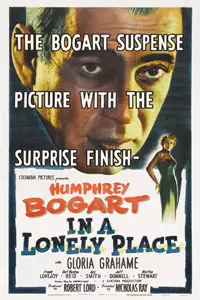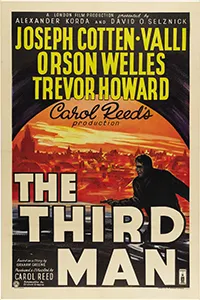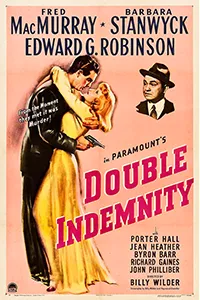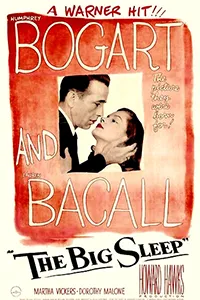IN A LONELY PLACE
In a genre known for its cynical worldview and dark themes, “In a Lonely Place” stands out as a haunting exploration of isolation and paranoia. Directed by Nicholas Ray and starring Humphrey Bogart and Gloria Grahame, this 1950 classic follows a troubled screenwriter who becomes the prime suspect in a murder investigation. But as the story unfolds, it becomes clear that the real mystery lies in the protagonist’s troubled psyche and his inability to connect with those around him. With its gripping performances and atmospheric visuals, “In a Lonely Place” remains a landmark of the film noir genre.
PLOT
The plot centers around Dixon Steele (Bogart), a Hollywood screenwriter who is suspected of murdering a young woman named Mildred Atkinson. Steele is initially considered a suspect in the murder due to his volatile personality and his tendency to get into fights. However, after being questioned by the police, he is released and cleared of the charges due to a lack of evidence.
Despite his exoneration, Steele’s reputation and mental state are deeply affected by the accusations. He becomes increasingly isolated and paranoid, and his relationships with those around him begin to unravel. In particular, his relationship with his neighbor Laurel Gray (Grahame) becomes increasingly strained, as she begins to suspect that he may have had something to do with Mildred’s death.

Throughout the film, there are multiple instances where characters have differing recollections of events, and it is left to the viewer to decide what is real and what is a product of their own biases and perceptions. For example, Steele has a memory lapse during a key scene in which he is discussing the plot of a potential movie adaptation with Mildred. Later, Laurel recounts the same scene, but with significant differences in the details. This ambiguity is further reinforced by the use of shadow and light in the film’s cinematography, which creates a sense of unease and uncertainty.
As the story progresses, it becomes increasingly clear that Steele’s mental state is deteriorating. He becomes increasingly volatile and paranoid, and his behavior becomes more erratic. Meanwhile, Laurel becomes increasingly fearful of him, but is still drawn to his creativity and intelligence.

In the film’s climactic scene, Steele has a violent outburst in which he attacks Laurel. However, he is eventually subdued and taken away by the police. The film ends with Laurel sitting alone in her apartment, reflecting on the events that have transpired.
Overall, “In a Lonely Place” is a haunting exploration of isolation and paranoia. The film’s complex characters and ambiguous plot make for a gripping and thought-provoking viewing experience, and the exceptional performances by Bogart and Grahame make it a true classic of the film noir genre.
THEMES
“In a Lonely Place” is a film that delves deeply into a range of themes relevant to the film noir genre. Through its nuanced characters, intricate plot, and use of symbolism and metaphor, the film explores themes such as toxic masculinity, the nature of truth, power dynamics, and the corrupting influence of Hollywood.
One of the most prominent themes in the film is the danger of toxic masculinity and the way in which it can lead to violence and destruction. Dixon Steele, the film’s protagonist, is initially presented as a charming and intelligent man. However, as the story progresses, it becomes clear that he has a deeply troubled and violent side. His tendency to get into fights and his explosive temper are a source of concern for those around him, and his isolation and sense of entitlement exacerbate these issues. Ultimately, his toxic behavior leads him down a path of self-destruction, culminating in the violent outburst that ends the film.

The film’s exploration of toxic masculinity is particularly relevant in the context of Hollywood, where powerful men have long been accused of abusing their positions to control and manipulate those around them. Through Steele’s character, the film highlights the danger of unchecked male entitlement and the way in which it can lead to violence and destruction.
Another theme explored in the film is the nature of truth and perception. Throughout the story, different characters have different recollections of events, and it is left to the viewer to decide what is real and what is a product of their own biases and perceptions. This ambiguity is further reinforced by the use of shadow and light in the film’s cinematography, which creates a sense of unease and uncertainty. The film’s exploration of truth and perception is particularly relevant in the context of Hollywood, where appearances and perceptions are often more important than reality.
The film also explores power dynamics between men and women, particularly in the context of the film industry. Steele’s position as a successful screenwriter gives him a sense of entitlement and power, which he uses to manipulate and control those around him. Laurel, the film’s female protagonist, is initially drawn to Steele’s intelligence and creativity, but becomes increasingly aware of the danger he poses. The film’s portrayal of Laurel as a strong and independent woman who is ultimately able to see through Steele’s facade is notable for its subversion of the typical femme fatale trope.
The film’s use of Los Angeles as a setting is also notable. The city is portrayed in a stark and unflattering light, with the seedy underbelly of Hollywood contrasted with the glamour and glitz of the industry. This contrast serves to highlight the darker aspects of the film industry and the way in which it can corrupt those who are drawn to its allure.
Finally, the film’s use of symbolism and metaphor adds another layer of depth to its exploration of themes. For example, Steele’s use of a typewriter throughout the film serves as a symbol of his power as a writer and his ability to manipulate reality through his words. The film’s use of shadow and light is also highly symbolic, with the shadows representing the hidden and often dangerous aspects of human nature.
“In a Lonely Place” is a highly nuanced and thought-provoking film that explores a range of themes relevant to the film noir genre. Its complex characters, ambiguous plot, and exceptional performances make it a true classic of the genre, and its exploration of themes such as toxic masculinity, power dynamics, and the nature of truth continue to resonate with audiences today. The film’s use of symbolism and metaphor adds another layer of depth to its exploration of themes, making it a masterful example of the art of filmmaking.
RECEPTION
 When “In a Lonely Place” was released in 1950, it received generally positive reviews from critics. The film was praised for its performances, particularly that of Humphrey Bogart, who delivered one of his most nuanced and complex portrayals.
When “In a Lonely Place” was released in 1950, it received generally positive reviews from critics. The film was praised for its performances, particularly that of Humphrey Bogart, who delivered one of his most nuanced and complex portrayals.
Critics also praised the film’s exploration of themes such as the nature of creativity, the allure of fame, and the difficulties of relationships. The film was noted for its sharp dialogue, its exploration of the darker side of Hollywood, and its evocative portrayal of the post-World War II era.
Despite its critical acclaim, “In a Lonely Place” was not a commercial success upon its release. Some audiences found the film to be too dark and depressing, and its exploration of the harsh realities of Hollywood and relationships may have been too unsettling for some viewers.
Over time, however, the film has become recognized as a classic of the film noir genre and is now regarded as one of the best examples of post-World War II Hollywood filmmaking. The film’s exploration of complex themes and its nuanced portrayal of flawed characters have made it a favorite among cinephiles and scholars of American cinema.
“In a Lonely Place” has also been recognized for its influence on later filmmakers and films. Director Martin Scorsese has cited the film as a major influence on his work, particularly his exploration of male insecurity and violence. The film’s use of subjective camera shots and its exploration of the dark underbelly of Hollywood have also been echoed in films such as Sunset Boulevard and “Mulholland Drive.”
POPULAR CULTURE
“In a Lonely Place” is a film that has had a significant impact on popular culture and has been referenced and paid homage to in various ways over the years.
The film has also been referenced in other films and TV shows. For example, the 1997 film “L.A. Confidential” pays homage to “In a Lonely Place” through its portrayal of the darker side of Hollywood and its exploration of themes such as corruption and toxic masculinity. Similarly, the TV series “Mad Men” references the film through its portrayal of the advertising industry and the toxic behavior of its male characters.
Here’s a selection of other examples:
In the 1991 film “The Silence of the Lambs,” the character of Dr. Hannibal Lecter is seen watching a scene from “In a Lonely Place” on his television. This brief reference to the film underscores the character’s appreciation for high culture and his ability to see through the veneer of Hollywood glamour.
The 1997 film “Gattaca” features a scene in which the protagonist watches “In a Lonely Place” on his television. The scene is meant to show the character’s fascination with the film’s themes of alienation and identity.
The 2011 film “Drive” has been compared to “In a Lonely Place” for its depiction of a loner hero who is drawn into a violent underworld. Both films explore themes of masculinity, power, and the dark side of human nature.
The 2014 video game “L.A. Noire” features a case called “A Walk in Elysian Fields,” which is heavily inspired by “In a Lonely Place.” The case involves a Hollywood producer who is accused of murder, and the player must navigate a complex web of lies and deceit in order to solve the case.
The 2017 TV series “Twin Peaks: The Return” features a scene in which the character of Gordon Cole watches “In a Lonely Place” on his hotel room television. The scene serves as a nod to the film’s influence on director David Lynch and his exploration of similar themes in his own work.
These examples demonstrate how “In a Lonely Place” has been woven into the fabric of popular culture, inspiring and influencing artists in a variety of fields. The film’s exploration of complex themes continues to resonate with audiences and inspire new generations of artists to explore similar ideas in their own work.
FURTHER READING
Read more about how Director Nicholas Ray used inspiration from his own life to create some of the sets for the film:
“These 1920s apartments inspired one of the best noir films ever made”
Explore more Film Noir

Classic film noir set in post-WWII Vienna, where a writer investigates the mysterious death of his friend.

A gripping film noir about a seductive woman who convinces an insurance salesman to plot a murder.

This classic film noir follows private detective Philip Marlowe as he investigates a complex case involving a wealthy family.
